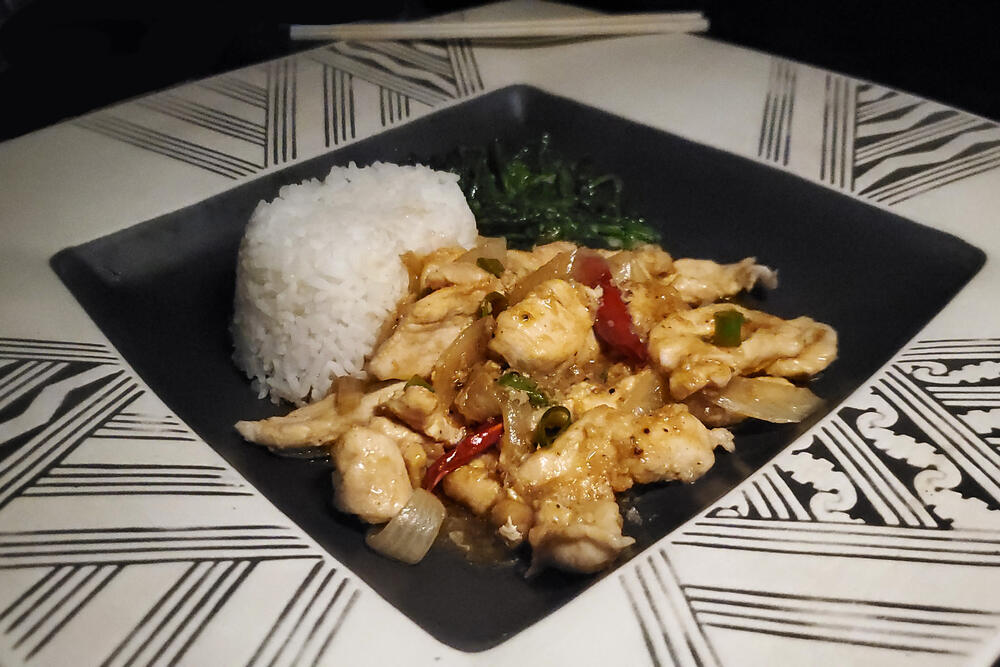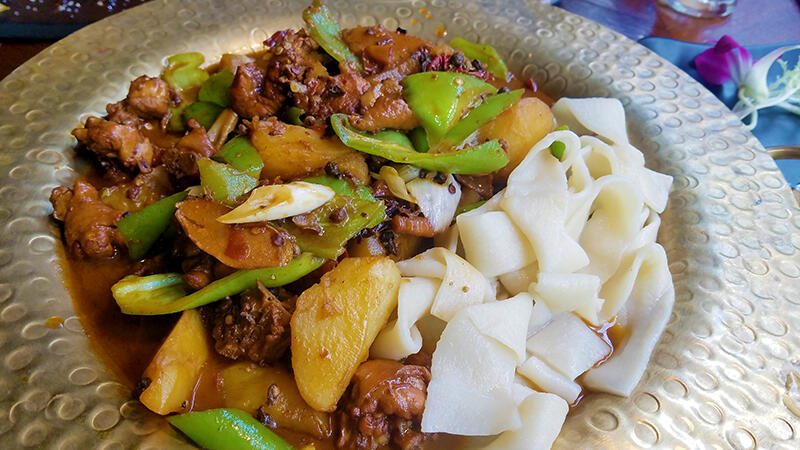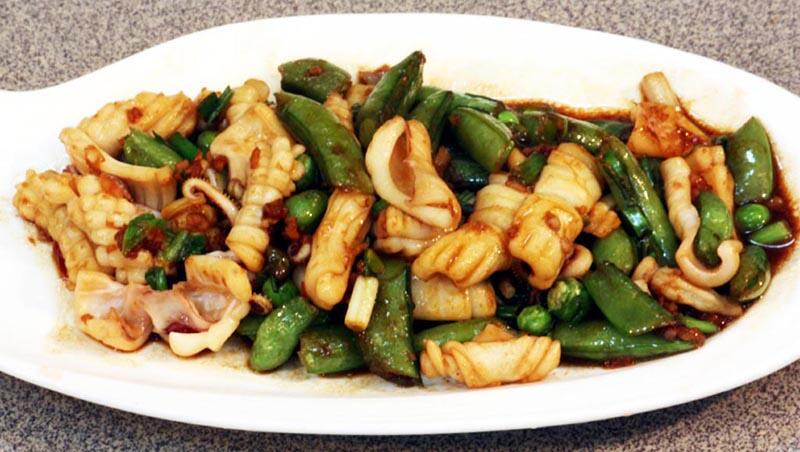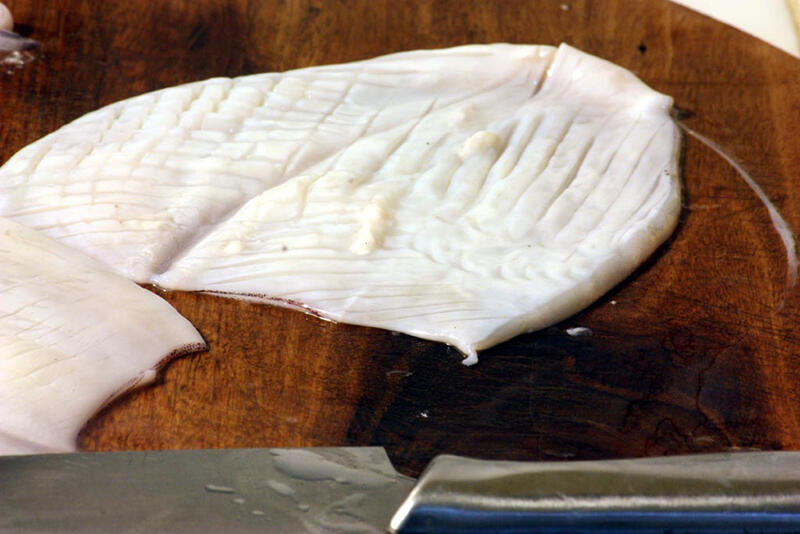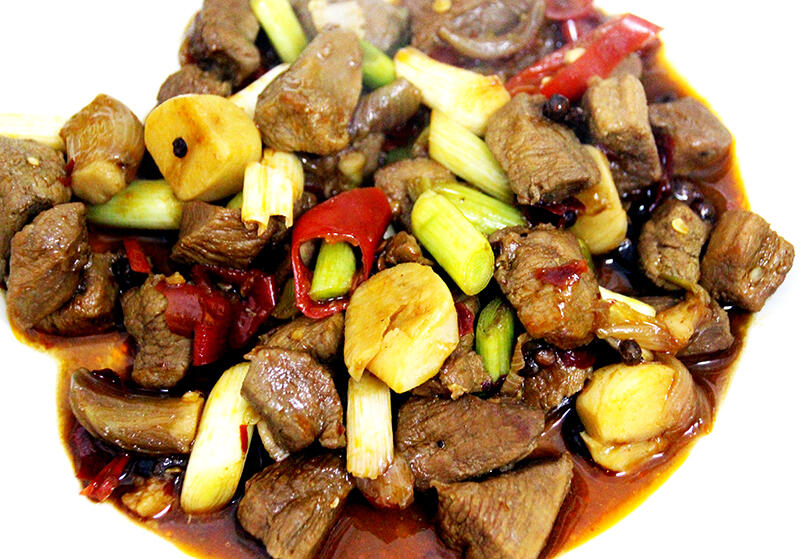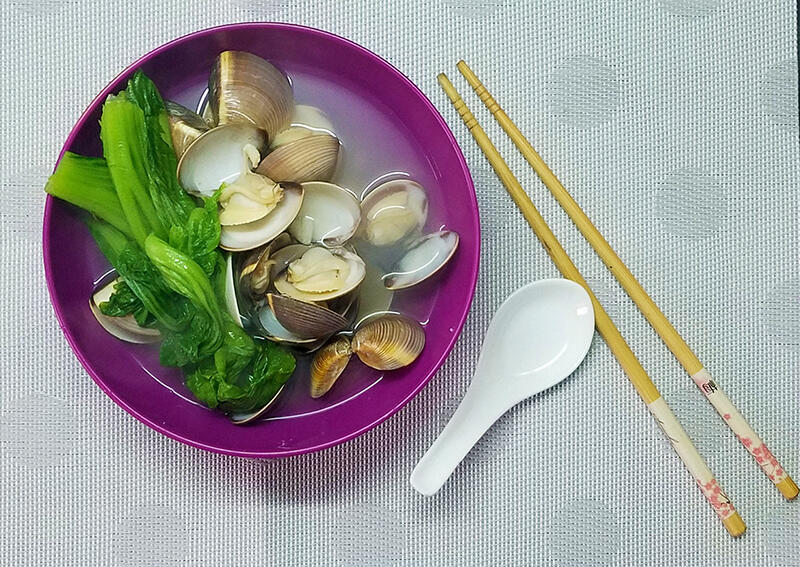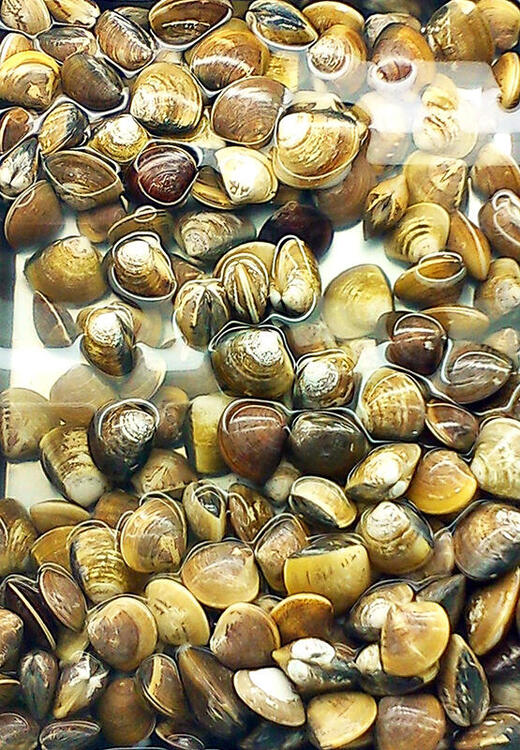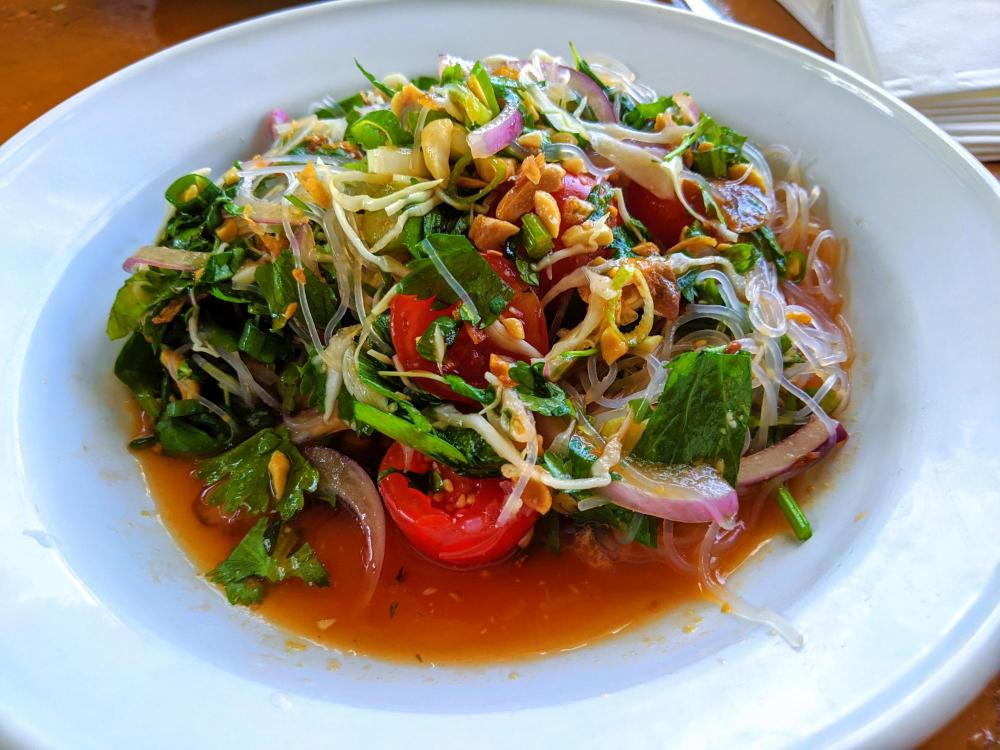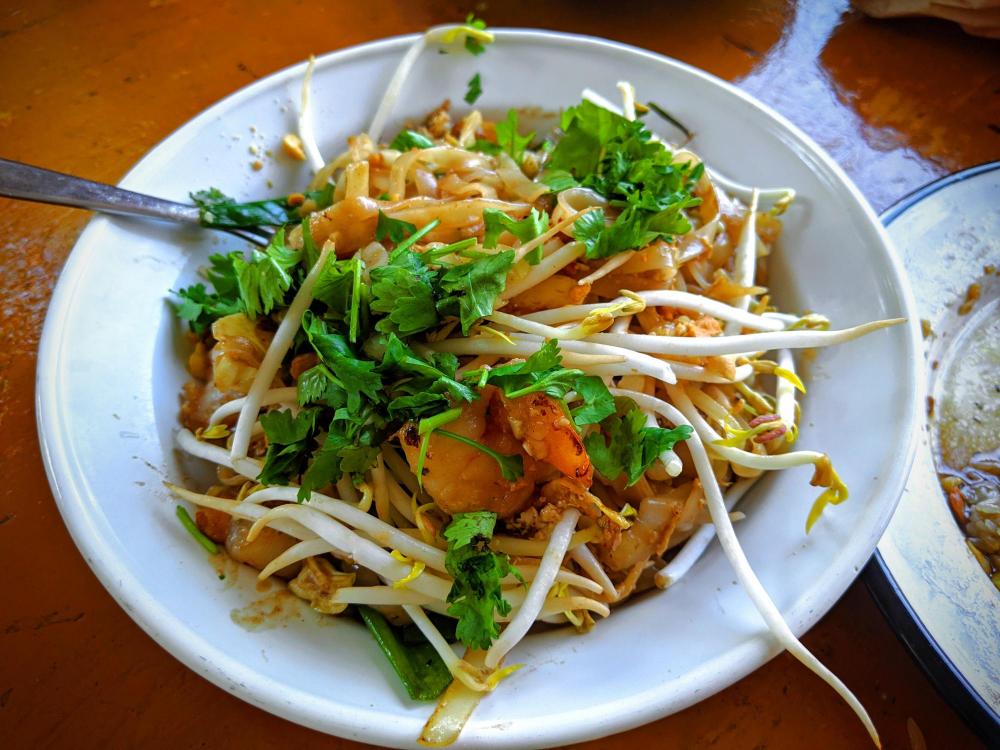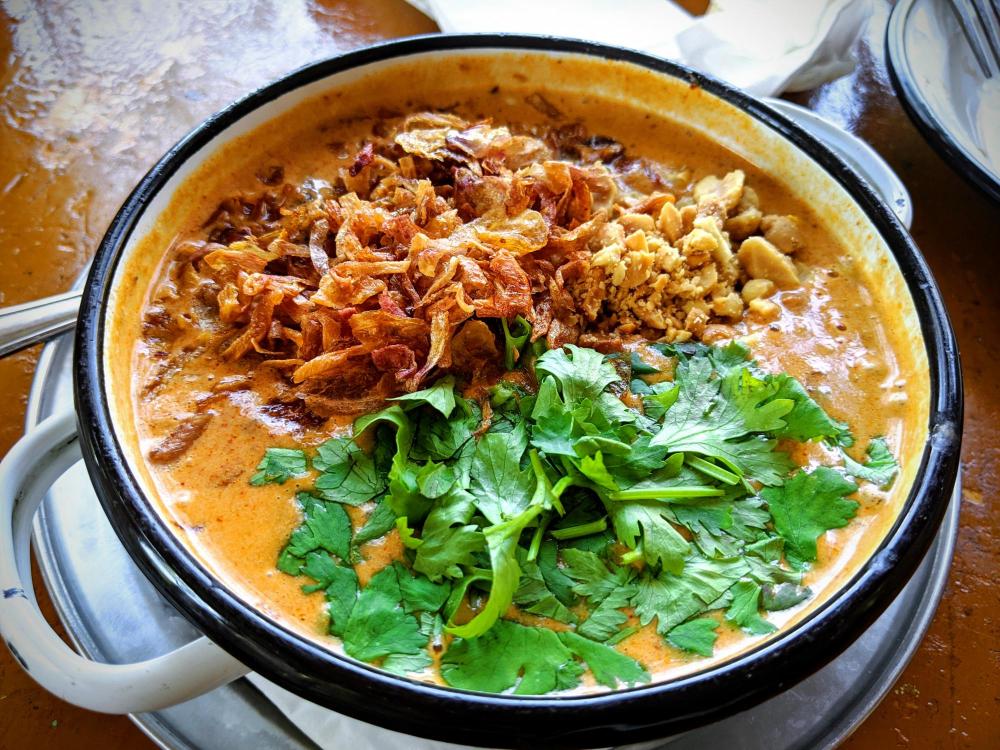Search the Community
Showing results for 'wok'.
Found 5,150 results
-
The excellent and aforementioned Chinese Cooking Demystified has a new video discussing home stir fry techniques which appears to have been inspired by a longer conversation on Kenji's channel (which I have not yet watched). They observe in an excerpt from that discussion that a lot of the obsession with high powered burners is borne from a focus on restaurant technique that isn't really something Chinese home cooks think about. They also note that a lot of the issues people attribute to a not-hot-enough burner is really from using a wok that's too small or putting too much food in at once. (Not exactly new information for this thread but it was a nice discussion.) That said, as someone with a flat top radiant stove, I've been quite tempted by the Iwatani 35FW — but for reasons of control, rather than heat output.
-
As @liuzhou mentioned, you can make wonderful Chinese food without a wok as evidenced by @hzrt8w's eGullet Chinese food pictorials (click)...not a wok in sight.
-
All you need is a wok, preferably carbon steel or cast iron, and maybe a wok stand depending on your regular stove. Unless you are a restaurant. Chinese home cooks do not have butane burners and in a quarter of a century in China, I've never seen an electric wok! 1.4 billion people here use woks, usually more than once a day. On regular stoves and seldom ouside.
-
hello, guys since that's the only thread about wok (which I've managed to find), I want to ask you, which woks are you using? I'm really into Asian cuisine, and I'd like to make a simple wok dish at home. I've read this article, but still have no clue choosing the right equipment! Any help would be appreciated Thanks a lot!
-
I understand you dry it, oil it and wipe it out before putting it away. But the next time you use it, do you heat it, put a tiny drop of oil in it, and wipe it out before you start actually cooking in it. Because this is the method I use for all non non-stick pans (i.e. cast iron, whatever my wok is made out of, carbon steel). Even when using stainless steel or lined copper, the pan needs to be at a proper temperature for stuff not to stick.
-
I confess that I flunked "seasoning 1". I have meticulously followed manufacturers' instructions only to wind up with an unseasoned pan. BUT most all of my cast iron pans and one Dutch oven, my calphlon dedicated to deep frying and several woks have become perfectly seasoned. Because, I believe, they are used consistently with oils and never scoured clean. The Dutch oven is one I use for bread and which I spray with cooking spray each use and only rinse out with water. In my mental "notebook", it is the repeated use of oil that is allowed to gradually adhere that creates the desired surface.
-
Did crepes today @ 335 F on a dubuyer crepe pan (mineral B IIRC). Did a quick pre-heat to 400 with some oil in there, wok style. It worked very well, browned but not overly so, quickly cooked. The dubuyer pans seem to overshoot quite a bit on the initial heating, so letting it go back down a bit to stay out of butter burn zone is good idea (I use butter to cook them, with that very thin film of oil from the initial heating left in there). This is much better the trying to move the gas knob a hair or two back and forth. I think breaking out the big crepe pan and hitting up some galettes might be in order.
-
Breakfast. "Velveted" the chicken. Stir fried onions, garlic, ginger, tossed the chicken back into the wok. Added a couple of spoons of black pepper sauce, chicken broth, salt and white pepper. Tossed in a few dried red chili peppers and topped with chopped green onion. Served with steamed rice and spinach sauted with minced garlic.
-
One favourite here among the rice eaters is 土豆丝 (tǔ dòu sī ) or slivered potatoes with vinegar. Several of the recipes on Google include bell peppers. Never! It is matchstick slivers of potato with chilli, Sichuan peppercorns, garlic and vinegar. Often slivered carrot is mixed with the potato, but in lesser quantities. 1 part carrot to three parts potato. 1 large potato dried chili peppers (to taste) If you can get them, dried "facing heaven chillies" are best 1 tsp Sichuan peppercorns 1/2 tbsp light soy sauce 2 cloves garlic, minced 2 tsp vinegar (most recipes recommend Zhenjiang (Chinkiang) vinegar, but I usually use white rice vinegar, instead) 1 tbsp vegetable cooking oil spring onion / scallion cilantro / coriander salt and white pepper Peel and clean potatoes (and carrots if using) and cut into matchstick sized slivers. Try to keep them all as near as possible to the same size. I suggest using a cleaver or sharp cook's knife. Food processors or other methods never work for me. Soak the potato (and carrot) in ice cold water for around ten minutes. Drain and dry with a towel. Heat your wok or skillet add oil then the chillies and peppercorns. As soon as you detect their fragrance, add the potato slivers and stir fry until they soften. Add soy sauce. Season with salt and ground white pepper. Add the vinegar, stir and serve garnished with the cilantro / coriander.
-
That Pyrex some of the pulled pork was in, in my last post? I put it into a different bowl and my husband let the dog lick the pork fat it. 🙈 I tried to dry fry green beans but I should have done them in the wok. They were dull. I gave the dog some. We also had Mac and cheese. The dog didn’t get any of that. But she’s probably the most sated out of all of us.
-
Sure. It's from Marion's Kitchen. Spicy Peanut Noodle Soup INGREDIENTS 3 tbsp vegetable oil 3 garlic cloves, finely chopped 3cm piece ginger, finely chopped 1 tsp chilli powder (or to taste) 1 tsp sweet paprika 200g (7 oz) pork mince 2 tbsp crunchy peanut butter 2 tbsp soy sauce 1 tbsp vinegar 5 cups chicken stock 400g (14 oz) cooked noodles 12 frozen dumplings Finely sliced spring onion (scallions), to serve INSTRUCTIONS STEP 1 Heat the vegetable oil in a wok or large saucepan over medium-high heat. Add the garlic, ginger, chilli and paprika. Stir-fry for half a minute. Then add the pork and stir-fry until almost cooked. Add the peanut butter, soy sauce and vinegar and stir-fry for about 2 minutes or until thick and bubbling. Add the chicken stock and simmer for 2-3 minutes. Taste and season with extra soy sauce or salt to taste. STEP 2 Cook dumplings in boiling water according to packet instructions. STEP 3 Divide pork soup among serving bowls. Add cooked noodles and top with dumplings. Sprinkle with spring onion and serve.
-
I think a large part of this is that us Westerners are much more exposed to restaurant style cooking and street food than we are to home cooking. This is also visible in going for particular type of dishes (e.g. stir fired noodles, dumplings) rather than others (e.g. broths, simple cooked vegetable dishes). As to cheaters wok hei, I often brush a few of the ingredients with oil before lightly charring them on a flame. Then I chop them as needed and stir fry over high flame as usual. This usually gives enough of the smoky flavor for my taste.
-
Big Plate Chicken - 大盘鸡 (dà pán jī) This very filling dish of chicken and potato stew is from Xinjiang province in China's far west, although it is said to have been invented by a visitor from Sichuan. In recent years, it has become popular in cities across China, where it is made using a whole chicken which is chopped, with skin and on the bone, into small pieces suitable for easy chopstick handling. If you want to go that way, any Asian market should be able to chop the bird for you. Otherwise you may use boneless chicken thighs instead. Ingredients Chicken chopped on the bone or Boneless skinless chicken thighs 6 Light soy sauce Dark soy sauce Shaoxing wine Cornstarch or similar. I use potato starch. Vegetable oil (not olive oil) Star anise, 4 Cinnamon, 1 stick Bay leaves, 5 or 6 Fresh ginger, 6 coin sized slices Garlic. 5 cloves, roughly chopped Sichuan peppercorns, 1 tablespoon Whole dried red chillies, 6 -10 (optional). If you can source the Sichuan chiles known as Facing Heaven Chiles, so much the better. Potatoes 2 or 3 medium sized. peeled and cut into bite-sized pieces Carrot. 1, thinly sliced Dried wheat noodles. 8 oz. Traditionally, these would be a long, flat thick variety. I've use Italian tagliatelle successfully. Red bell pepper. 1 cut into chunks Green bell pepper, 1 cut into chunks Salt Scallion, 2 sliced. Method First, cut the chicken into bite sized pieces and marinate in 1½ teaspoons light soy sauce, 3 teaspoons of Shaoxing and 1½ teaspoons of cornstarch. Set aside for about twenty minutes while you prepare the rest of the ingredients. Heat the wok and add three tablespoons cooking oil. Add the ginger, garlic, star anise, cinnamon stick, bay leaves, Sichuan peppercorns and chilies. Fry on a low heat for a minute or so. If they look about to burn, splash a little water into your wok. This will lower the temperature slightly. Add the chicken and turn up the heat. Continue frying until the meat is nicely seared, then add the potatoes and carrots. Stir fry a minute more then add 2 teaspoons of the dark soy sauce, 2 tablespoons of the light soy sauce and 2 tablespoons of the Shaoxing wine along with 3 cups of water. Bring to a boil, then reduce to medium. Cover and cook for around 15-20 minutes until the potatoes are done. While the main dish is cooking, cook the noodles separately according to the packet instructions. Reserve some of the noodle cooking water and drain. When the chicken and potatoes are done, you may add a little of the noodle water if the dish appears on the dry side. It should be saucy, but not soupy. Add the bell peppers and cook for three to four minutes more. Add scallions. Check seasoning and add some salt if it needs it. It may not due to the soy sauce and, if in the USA, Shaoxing wine. Serve on a large plate for everyone to help themselves from. Plate the noodles first, then cover with the meat and potato. Enjoy.
-
Stir-fried Squid with Snow Peas - 荷兰豆鱿鱼 Another popular restaurant dish that can easily be made at home. The only difficult part (and it's really not that difficult) is preparing the squid. However, your seafood purveyor should be able to do that for you. I have given details below. Ingredients Fresh squid. I tend to prefer the smaller squid in which case I allow one or two squid per person, depending on what other dishes I'm serving. You could use whole frozen squid if fresh is unavailable. Certainly not dried squid. Snow peas aka Mange Tout. Sugar snap peas can also be used. The final dish should be around 50% squid and 50% peas, so an amount roughly equivalent to the squid in bulk is what you are looking for. De-string if necessary and cut in half width-wise. Cooking oil. I use rice bran oil, but any vegetable cooking oil is fine. Not olive oil, though. Garlic. I prefer this dish to be rather garlicky so I use one clove or more per squid. Adjust to your preference. Ginger. An amount equivalent to that of garlic. Red Chile. One or two small hot red chiles. Shaoxing wine. See method. Note: Unlike elsewhere, Shaoxing wine sold in N. America is salted. So, cut back on adding salt if using American sourced Shaoxing. Oyster sauce Sesame oil (optional) Salt Preparing the squid The squid should be cleaned and the tentacles and innards pulled out and set aside while you deal with the tubular body. Remove the internal cartilage / bone along with any remaining innards. With a sharp knife remove the "wings" then slit open the tube by sliding your knife inside and cutting down one side. Open out the now butterflied body. Remove the reddish skin (It is edible, but removing it makes for a nicer presentation. It peels off easily.) Again, using the sharp knife cut score marks on the inside at 1/8th of an inch intervals being careful not to cut all the way through. Then repeat at right angles to the original scoring, to give a cross-hatch effect. Do the same to the squid wings. Cut the body into rectangles roughly the size of a large postage stamp. Separate the tentacles from the innards by feeling for the beak, a hard growth just above the tentacles and at the start of the animal's digestive tract. Dispose of all but the tentacles. If they are long, half them. Wash all the squid meat again. Method There are only two ways to cook squid and have it remain edible. Long slow cooking (an hour or more) or very rapid (a few seconds) then served immediately. Anything else and you'll be chewing on rubber. So that is why I am stir frying it. Few restaurants get this right, so I mainly eat it at home. Heat your wok and add oil. Have a cup of water to the side. Add the garlic, ginger and chile. Should you think it's about to burn, throw in a little of that water. It will evaporate almost immediately but slow down some of the heat. As soon as you can smell the fragrance of the garlic and ginger, add the peas and salt and toss until the peas are nearly cooked (Try a piece to see!). Almost finally, add the squid with a tablespoon of the Shaoxing and about the same of oyster sauce. Do not attempt to add the oyster sauce straight from the bottle. The chances of the whole bottle emptying into your dinner is high! Believe me. I've been there! The squid will curl up and turn opaque in seconds. It's cooked. Sprinkle with a teaspoon of so of sesame oil (if used) and serve immediately!
-
I dunno. I haven't the patience to become a good cook of Asian dishes. But I do crank up the exhaust fans and heat the wok to smoking, sear veg and quickly brown marinated meat and chicken. It may not reach the heights of wok hei, but it's enough to create memorable flavor and even more lasting kitchen schmutz.
-
Burnt food is indeed unhealthy, *IF* carbon is being created - however, Wok Hei is the searing / slight browning of anything (I suppose?), thus creating a smokey/toasted aroma. Pre-carbon creation, no doubt. Take for example Beef Ho Fun - the noodles especially are to be toasted to create a bit of browning, as are any veg, thus the Wok Hei technique is accomplished. Same concept for the aforementioned cabbage example, browning/blistering the veg not only caramelizes the sugars, but will also create a smokey note - which is the essence of Wok Hei.
-
That would certainly boost the flavor, wok hei be damned!
-
My uneducated opinion: 1. I have never seen browning vegetables in a Chinese restaurant. Browning food is generally considered unhealthy and to be avoided. 2. Blast furnace hot stove creates appetizing aroma in the air (wok hei?). 3. Blast furnace hot stove for restaurants cooks food faster, and therefore faster customer turnover. 4. In the old China days, pork fat was used frequently for cooking, and fatty meat was preferred. Yes, extreme heat makes lots of aromatic hydrocarbons and Maillard reaction with fat. But high heat does not much to lean chicken white meat cooked in vegetable oil. dcarch
-
Apologies to David Byrne et al. In an attempt to become as annoying as Alton Brown, Kenji writes about how to achieve that elusive wok hei at home. Exactly what @liuzhou has been telling us for years. And as an old (er) home cook, I try to make great food at home for sure - but I don't try to be a restaurant. Well - this is for those who do... https://www.nytimes.com/2020/09/04/dining/stir-fry-recipe-wok-hei.html?action=click&module=Features&pgtype=Homepage
-
Thanks to everyone who answered my plea! You helped more than you may know. I agree that few people there may actually go on to make any of these dishes, but some may find them interesting anyway. Here, in recognition of the debt, is what I finally submitted. I am sure there are still some errors. Feel free to point out any you spot! Edited to note: This was the first draft. The full edited recipes (incorporating suggestions given here) are now on the RecipeGullet Forum. September 12, 2020 车螺芥菜汤 Clam Soup with Mustard Greens This is a popular, light but peppery soup available in most Liuzhou restaurants (even if its not listed on the menu). Also, very easy to make at home. Ingredients Clams. (around 8 to 10 per person. Some restaurants are stingy with the clams, but I like to be more generous). Fresh live clams are always used in China, but if, not available, I suppose frozen clams could be used. Not canned. Live clams should be kept in cold water until you are ready to cook them. The most common clams here are relatively small. Littleneck clams may be a good substitute. Stock. Chicken, fish or clam stock are preferable. Stock made from cubes or bouillon powder is acceptable, although fresh is always best. Mustard Greens. (A good handful per person. Remove the thick stems, to be used in another dish.) Garlic. (to taste) Chile. (One or two hot red chiles are optional). Salt. MSG (optional). If you have used a stock cube or bouillon powder for the stock, omit the MSG. The cubes and power already have enough. White pepper (frehly ground. I recommend adding what you consider to be slightly too much pepper, then adding half that again. The soup should be peppery, although of course everything is variable to taste.) Method Bring your stock to a boil. Add salt to taste along with MSG if using. Finely chop the garlic and chile if using. Add to stock and simmer for about five minutes. Make sure all the clams are tightly closed, discarding any which are open - they are dead and should not be eaten. The clams will begin to pop open fairly quickly. Remove the open ones as quickly as possible and keep to one side while the others catch up. One or two clams may never open. These should also be discarded. When you have all the clams fished out of the boiling stock, roughly the tear the mustard leaves in two and drop them into the stock. Simmer for one minute. Put all the clams back into the stock and when it comes back to the boil, take off the heat and serve. ___________________________________________________________ 荷兰豆鱿鱼 Stir-fried Squid with Snow Peas Another popular restaurant dish that can easily be made at home. The only difficult part (and it's really not that difficult) is preparing the squid. However, your seafood purveyor should be able to do that for you. I have given details below. Ingredients Fresh squid. I tend to prefer the smaller squid in which case I allow one or two squid per person, depending on what other dishes I'm serving. You could use whole frozen squid if fresh is unavailable. Certainly not dried squid. Snow peas aka Mange Tout. Sugar snap peas can also be used. The final dish should be around 50% squid and 50% peas, so an amount roughly eqivalent to the squid in bulk is what you are looking for. De-string if necessary and cut in half width-wise. Cooking oil. I use rice bran oil, but any vegetable cooking oil is fine. Not olive oil, though. Garlic. I prefer this dish to be rather garlicky so I use one clove or more per squid. Adjust to your preference. Ginger. An amount equivalent to that of garlic. Red Chile. One or two small hot red chiles. Shaoxing wine. See method. Note: Unlike elsewhere, Shaoxing wine sold in N. America is salted. So, cut back on adding salt if using American sourced Shaoxing. Oyster sauce Sesame oil (optional) Salt Preparing the squid The squid should be cleaned and the tentacles and innards pulled out and set aside while you deal with the tubular body. Remove the internal cartilege / bone along with any remaining innards. With a sharp knife remove the "wings" then slit open the tube by sliding your knife inside and cutting down one side. Open out the now butterflied body. Remove the reddish skin (It is edible, but removing it makes for a nicer presentation. It peels off easily.) Again, using the sharp knife cut score marks on the inside at 1/8th of an inch intervals being careful not to cut all the way through. Then repeat at right angles to the original scoring, to give a cross-hatch effect. Do the same to the squid wings. Cut the body into rectangles roughly the size of a large postage stamp. Separate the tentacles from the innards by feeling for the beak, a hard growth just above the tentacles and at the start of the animal's digestive tract. Dispose of all but the tentacles. If they are long, half them. Wash all the squid meat again. Method There are only two ways to cook squid and have it remain edible. Long slow cooking (an hour or more) or very rapid (a few seconds) then served immediately. Anything else and you'll be chewing on rubber. So that is why I am stir frying it. Few restaurants get this right, so I mainly eat it at home. Heat your wok and add oil. Have a cup of water to the side. Add the garlic, ginger and chile. Should you think it's about to burn, throw in a little of that water. It will evaporate almost immediately but slow down some of the heat. As soon as you can smell the fragrance of the garlic and ginger, add the peas and salt and toss until the peas are nearly cooked (Try a piece to see!). Almost finally, add the squid with a tablespoon of the Shaoxing and about the same of oyster sauce. Do not attempt to add the oyster sauce straight from the bottle. The chances of the whole bottle emptying into your dinner is high! Believe me. I've been there! The squid will curl up and turn opaque in seconds. It's cooked. Sprinkle with a teaspoon of so of sesame oil (if used) and serve immediately! ___________________________________________________________ 啤酒鸭 Beer Duck I understand that, unlike in China, duck is not a common meat in the USA, but it is worth searching out, especially for this dish from Hunan which is basically a duck stew, but full of exquisite flavors. I'm told that frozen duck meat is available in larger supermarkets or Asian markets in Cincinnatti, but of course, as always, fresh is best. So much so, that your average Chinese home cook will buy the bird alive! Ingredients Duck. 1 lb. This dish calls for cubes of duck meat, preferably from the legs/thighs but breast meat will work too. Beer. One large can (16oz). Ideally you would choose a Chinese beer. Tsingtao is the most widely available internationally. Here in Liuzhou it would be Liquan Beer from Guilin. But actually, any well-flavored lager type beer will do the job. Cooking Oil. Vegetable oil - but not olive oil. If you have duck fat to hand, this is even better. Doubanjiang. 1 Tablespooon. Also called toban-djan or similar in the USA. This is a chile paste made with broad beans. Garlic. About 6-8 whole cloves Ginger. One thumb sized piece, finely chopped Dried Tangerine Peel. One large piece - available from Asian markets and stores. Star Anise. One Light Soy Sauce. 1 Tablespoon Dark Soy Sauce. 1 Tablespoon Scallions. Salt. Method Wash and thoroughly dry the cubed duck meat. Heat oil or fat and add the garlic and ginger. When you detect their fragrance, add the duck and stir to brown the meat. When browned, add the doubanjiang and stir for a couple of minutes. Add the two soy sauces, the star anise and tangerine peel. Cover with beer. Add salt. Cover the pan and simmer for 30 - 40 minutes, adding more beer if it begins to dry out. Finish by discarding the star anise and tangerine peel, but adding thinly sliced scallions and serve. Accompany with steamed rice and a stir fried green vegetable of your choice. I like spinach. Drink any remaiining beer! You didn't just buy one can, did you? ___________________________________________________________ 牛肉苦瓜 Beef with Bitter Melon The name may be off-putting to many people, but Chinese people do have an appreciation for bitter tastes and anyway, modern cultivars of this gourd are less bitter than in the past. Also, depending on how it's cooked, the bitterness can be mitigated. I'll admit that I wasn't sure at first, but have grown to love it. Note: "Beef with Bitter Melon (牛肉苦瓜)" or "Bitter Melon with Beef (苦瓜牛肉)"? One Liuzhou restaurant I know has both on its menu! In Chinese, the ingredient listed first is the one there is most of, so, "beef with bitter melon" is mainly beef, whereas "bitter melon with beef" is much more a vegetable dish with just a little beef. This recipe is for the beefier version. To make the other version, just half the amount of beef and double the amount of melon. Ingredients Beef. One pound. Flank steak works best. Slice thinly against the grain. Bitter Melon. Half a melon. You can use the other half in a soup or other dish. Salted Black Beans. One tablespoon. Available in packets from Asian markets and supermarkets, these are salted, fermented black soy beans. They are used as the basis for 'black bean sauce', but we are going to be making our own sauce! Garlic. 6 cloves Cooking oil. Any vegetable oil except olive oil Shaoxing wine See method Light soy sauce One tablespoon Dark soy sauce One teaspoon White pepper See method Sesame oil See method Method Marinate the beef in a 1/2 tablespoon of light soy sauce with a splash of Shaoxing wine along with a teaspoon or so of cornstarch or similar (I use potato starch). Stir well and leave for 15-30 minutes. Cut the melon(s) in half lengthwise and, using a teaspoon, scrape out all the seeds and pith. The more pith you remove, the less bitter the dish will be. Cut the melon into crescents about 1/8th inch wide. Rinse the black beans and drain. Crush them with the blade of your knife, then chop finely. Finely chop the garlic. Stir fry the meat in a tablespon of oil over a high heat until done. This should take less than a minute. Remove and set aside. Add another tablespoon of oil and reduce heat to medium. fry the garlic and black beans until fragrant then add the bitter melon. Continue frying until the melon softens. then add a tablesoon of Shaoxing wine and soy sauces. Finally sprinkle on white pepper to taste along with a splash of sesame oil. Return the meat to the pan and mix everything well. Note: If you prefer the dish more saucy, you can add a tablespoon or so of water with the soy sauces. Serve with plained rice and a stir-fried green vegetable of choice. ___________________________________________________________ 大盘鸡 (dà pán jī ) Big Plate Chicken This very filling dish of chicken and potato stew is from Xinjiang province in China's far west, although it is said to have been invented by a visitor from Sichuan. In recent years, it has become popular in cities across China, where it is made using a whole chicken which is chopped, with skin and on the bone, into small pieces suitable for easy chopstick handling. If you want to go that way, any Asian market should be able to chop the bird for you. Otherwise you may use boneless chicken thighs instead. Ingredients Boneless skinless chicken thighs 6 Light soy sauce Dark soy sauce Shaoxing wine Cornstarch or similar. I use potato starch. Vegetable oil (not olive oil) Star anise, 4 Cinnamon, 1 stick Bay leaves, 5 or 6 Fresh ginger, 6 coin sized slices Garlic. 5 cloves, roughly chopped Sichuan peppercorns, 1 tablespoon Whole dried red chiles, 6 -10 (optional). If you can source the Sichuan chiles known as Facing Heaven Chiles, so much the better. Potatoes 2 or 3 medium sized. peeled and cut into bite-sized pieces Carrot. 1, thinly sliced Dried wheat noodles. 8 oz. Traditionally, these would be a long, flat thick variety. I've use Italian tagliatelle successfully. Red bell pepper. 1 cut into chunks Green bell pepper, 1 cut into chunks Salt Scallion, 2 sliced. Method First, cut the chicken into bite sized pieces and marinate in 1 1/2 teaspoons light soy sauce, 3 teaspoons of Shaoxing and 1 1/2 teapoons of cornstarch. Set aside for about twenty minutes while you prepare the rest of the ingredients. Heat the wok and add three tablespoons cooking oil. Add the ginger, garlic, star anise, cinnamon stick, bay leaves, Sichuan peppercorns and chiles. Fry on a low heat for a minute or so. If they look about to burn, splash a little water into your wok. This will lower the temperature slighty. Add the chicken and turn up the heat. Continue frying until the meat is nicely seared, then add the potatoes and carrots. Stir fry a minute more then add 2 teaspoons of the dark soy sauce, 2 tablespoons of the light soy sauce and 2 tablespoons of the Shaoxing wine along with 3 cups of water. Bring to a boil, then reduce to medium. Cover and cook for around 15 minutes until the potatoes are done. While the main dish is cooking, cook the noodles separately according to the packet instructions. Reserve some of the noodle cooking water and drain. When the chicken and potatoes are done, you may add a little of the noodle water if the dish appears on the dry side. It should be saucy, but not soupy. Add the bell peppers and cook for three to four minutes more. Add scallions. Check seasoning and add some salt if it needs it. It may not due to the soy sauce and Shaoxing. Serve on a large plate for everyone to help themselves from. Plate the noodles first, then cover with the meat and potato. Enjoy. ___________________________________________________________ I also sent them my recipe for Rou Jia Mo, a slightly rewritten version of the one here.
-
OP here. Thank you all for your comments. The only good quality 24" gas wall oven is BlueStar, but that needs to be mounted 7" away from the nearest wall, so not an option for me. Instead I'll use the wall space for pot/pan storage, and buy a 36" Hestan Range with gas oven instead of the planned 36" Hestan Rangetop. I probably wont use the Range's oven as much, and dont really want to give up the pot/pan storage under the stove, but I figure I can keep our woks in the oven and the rest of the pots/pans elsewhere without too much trouble.
-
Thanks for the suggestion but I’ve checked and it’s far enough away. The outside of the oven doesn’t get any where near hot enough to possibly affect the house and the front is far enough away that it isn’t an issue. I use that 160k BTU wok burner on the bottom shelf on top of the table with no problem at all. I do have a single use fire extinguisher not pictured at hand for safety, but it’s fine. As I use it more if I do think there could be a problem I can just pull the table away more than it already is.
-
I raised the surrender flag stir frying this vegetable at home because, invariably, by the time I plate it and serve it at the table it has turned or beginning to turn the color of very dark olive green and is chewy and dry. I had a very hot wok and stir fried for just about a minute. A very sad contrast to the Google images of the dish that had a bright green color and a bit of sauce I drool on.
-
Wow nice dishes and the mention of good wok hei. There was a place by my office that did it well. My assistant , the first time, ordered pad see ew and I was fearing mush but we got the perfect wok hei. A pleasant surprise. We went there weekly! Alternating with the Mexican mariscos place also around the corner. She couldn't handle a whole fried fish on the table so I only got to envy the other workers.
-
Thai. Returned to a place we visited a two months ago. Yum won sen. Mung bean noodles salad. Sweet-spicy-acidic, plenty of herbs. Phad phak bung. Stir fried morning glory and shrimps. Oyster sauce, fermented soy beans, soy sauce, nearly whole garlic cloves, chilies. Lots of "wok hei". With sticky rice. So good. Pad thai with eggs and shrimp (mixed it all up before remembering to take the picture). Really good, nice wok hei, well seasoned, not sweet or overly sauce. I'm always hesitant of ordering pad thai, it's often overly localized, but this place got my trust the last time. Still needed some extra chili sauce. Massaman curry with tofu, onions, potatoes, peanuts, fried shallots. A little too much tomato to my taste, but it was OK.








